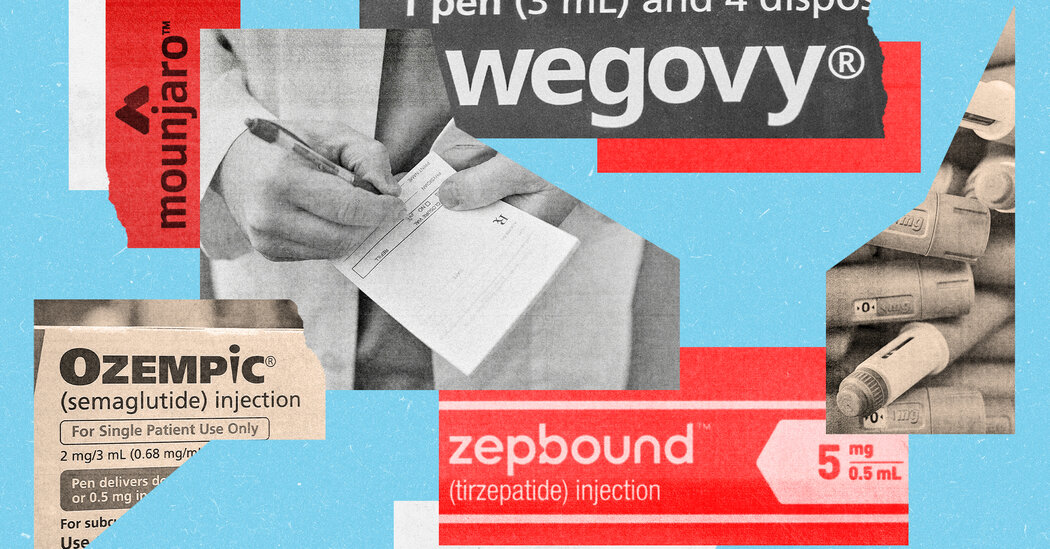News around drugs like Ozempic moves fast: There’s a steady drumbeat of new studies, new regulatory approvals, new shortages, new insurance hurdles. Here’s a primer on Ozempic and other popular drugs being widely used for diabetes and weight loss.
How do drugs like Ozempic work?
Ozempic belongs to a class of medications called GLP-1 receptor agonists, named after a hormone in the human body that they are designed to imitate.
In 2017, the Food and Drug Administration approved Ozempic to treat Type 2 diabetes, but people have also used the drug off-label to lose weight. In the last few years, other similar drugs have hit the market: Wegovy, a drug approved for weight loss and to reduce the risk of cardiovascular issues in some adults; Mounjaro, approved for Type 2 diabetes; and Zepbound, authorized for weight loss. These medications are all weekly shots.
Both Wegovy and Ozempic contain semaglutide, which mimics the hormone GLP-1 to stimulate insulin production in the pancreas and slow down stomach emptying, making people feel fuller faster, and for longer. Mounjaro and Zepbound work similarly, but they use tirzepatide (rather than semaglutide) to simulate both GLP-1 and a second hormone, GIP.
Crucially, semaglutide and tirzepatide also target the brain: They curb hunger signals, silencing what many users have called “food noise.”
The drugs don’t work for everyone. In clinical trials, a small fraction of participants have not lost significant weight or seen meaningful improvements in blood sugar control. “We haven’t quite figured out yet who will respond well,” said Dr. Scott Hagan, an assistant professor of medicine at the University of Washington who studies obesity.
But for many patients, the medications can be strikingly effective. An analysis of the longest and largest study on semaglutide, published this month, showed that participants who took the medication for four years were able to shed an average of around 10 percent of their body weight and sustain that weight loss. A major trial on tirzepatide showed that people who took the highest dose lost an average of around 18 percent of their body weight after 72 weeks.
“They’re just a game-changer,” said Dr. Melanie Jay, director of the N.Y.U. Langone Comprehensive Program on Obesity.
What are the side effects?
Patients tend to experience the most side effects when they start the medications and as they gradually increase their doses over the first few months, Dr. Jay said. The most common issues are gastrointestinal: nausea, vomiting, diarrhea, constipation, acid reflux, stomach pain and discomfort. People can also experience fatigue, dizziness and headaches.
Patients with Type 2 diabetes are also at an increased risk of developing hypoglycemia, or dangerously low blood sugar. In rare cases, patients on these drugs may experience pancreatitis and gallbladder or kidney issues.
Losing a lot of weight quickly can also have ripple effects. Some patients lose hair. Many also will lose muscle mass — which is particularly concerning for older adults at risk of becoming frail, Dr. Hagan said.
What else are these drugs being studied for?
Dozens of clinical trials are currently underway to test whether they could treat a slew of conditions, including chronic kidney disease, Alzheimer’s, liver disease, sleep apnea and polycystic ovary syndrome. The medications’ ability to induce weight loss might help with many of these conditions, but scientists speculate that the drugs have unique effects independent of weight loss — possibly by alleviating inflammation. They are also watching how the drugs impact the brain, and whether inhibiting cravings could also help with alcohol use disorder.
In March, the F.D.A. approved Wegovy to reduce the risk of heart attack, stroke and cardiovascular-related death in adults who have heart disease and are overweight or have obesity.
How much do these medications cost?
The list price of Ozempic is currently around $968 for a one-month supply. Wegovy runs about $1,349, Mounjaro is around $1,069 and Zepbound is about $1,059. Patients do not typically pay list price; many insurers cover the medications, although the extent of that coverage varies and some have introduced new restrictions. In addition, some patients can qualify for savings cards from drugmakers.
Because the drugs can be expensive, some people have sought out compounded semaglutide and tirzepatide — unauthorized medications that the F.D.A. has linked to adverse reactions. There is no generic version of semaglutide or tirzepatide.
How long do you take these drugs?
Drugs like Ozempic are considered indefinite prescriptions, Dr. Hagan said, like blood pressure medications or statins. When you stop taking them, they stop working. People taking the medications will inevitably hit a weight loss plateau, but if they go off the drugs, they typically regain some weight.
Some patients balk at the idea of staying on the medications for so long, Dr. Jay said: “Even if they say yes to you, six months later sometimes they’re like, ‘I didn’t want to be on this forever.’”
Because these medications are so new, we don’t yet know the lifelong effects, experts said. Those unknowns are one of the reasons doctors view these drugs as “medications for serious conditions,” Dr. Jay said. “These are not medications to lose 10 pounds or fit into some dress.”







